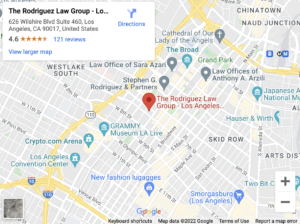Glendale Jail

The Los Angeles County correctional system is the largest in the U.S., operating nine facilities across its jurisdiction. An additional 77 city jails are run throughout the county as well. On any given day, these jails house tens of thousands of inmates.
One of the busiest facilities in Los Angeles County is the Glendale jail, with an average of 500–700 inmates getting booked into it each month.
Who Goes to the Glendale Jail in LA County?

The jail houses anyone who is arrested by the Glendale Police Department (GPD) or sentenced to serve time by local judges. The GPD enforces California state laws within the Glendale city limits.
Some offenses for which the GPD could arrest a person include the following:
- Homicide
- Assault
- Sexual assault
- Robbery
- Burglary, also called breaking and entering
- Other theft crimes
- Domestic violence
- Arson
- Driving under the influence
The Glendale jail has 48 cells with 96 beds. To minimize overcrowding, the facility only holds people arrested by the GPD until their first court appearance.
At that point, they will:
- Be released without bail
- Pay the bail set by the court
- Fail to pay bail
- Get held without bail
When inmates get held without bail or cannot pay the bail set during their hearing, they are transferred to the Los Angeles County jail system.
If you cannot locate someone who was arrested in Glendale, you should contact the GPD, the Superior Court at the Glendale Courthouse, or the Los Angeles County Sheriff’s Department. These entities will likely provide you with enough information to understand the status of your loved one’s case and learn which jail has them in custody.
Knowing their location and status will be helpful when you contact a Los Angeles criminal defense lawyer. An attorney can use that information to arrange a visit and see whether there is any way to get them released.
Is Anyone Else Held at the Glendale Jail?
Inmates in the Glendale jail also include those arrested by the GPD because of outstanding warrants in other jurisdictions. For example, suppose that you have a warrant for violating a restraining order in Riverside. If you are pulled over in Glendale, the GPD could arrest you on your warrant and hold you in the Glendale jail.
The Glendale city jail also houses Immigration and Customs Enforcement (ICE) detainees. ICE does not have enough space to hold all its detainees for violations of federal immigration laws. Glendale does not hold these inmates indefinitely, though. ICE detainees get transferred to long-term facilities or released after immigration hearings.
Finally, the Glendale jail participates in a program called “Pay-to-Stay Weekender,” which permits Los Angeles County jail inmates to pay to stay in the facility.
The benefits of the Pay-to-Stay Weekender program include the following:
- Inmates stay at the Glendale jail instead of one of the county’s jails
- Glendale jail segregates Pay-to-Stay inmates from the general jail population
- Inmates have access to day room areas, showers, and phones
- Inmates wear their own clothing instead of jail uniforms
In theory, Pay-to-Stay inmates are safer and more comfortable than inmates in Los Angeles County jails or the Glendale city jail’s general population. Otherwise, Pay-to-Stay inmates have access to the same or comparable facilities as other inmates.
To participate, you must:
- Apply for the program and receive approval from a magistrate
- Have no illnesses or conditions that require prescription medication
- Pay a fee of $96 per day upon reporting to Glendale
Despite its name as a “weekender” program, inmates do not report only on weekends. Once you report, you will stay in the Glendale jail continuously until the end of your sentence or your early release.
Inmate Processing at the Glendale Jail
People do not automatically end up in jail when the police receive a call. The responding officers will investigate the situation and determine whether anyone has committed a crime. If they have no evidence of a criminal offense, they cannot make an arrest.
Suppose that the police get called to a parking lot about an altercation. When they arrive, everyone says there was yelling but no threats or physical contact. Without any criminal violation, the police officers can only send everyone on their way.
But if the police find probable cause to believe that someone committed a crime, they can arrest them. After the arrest, the police will transport the arrestee to the Glendale jail. Once there, the arrestee will be booked.
Booking involves gathering identifying information about the arrestee’s identity. The officers will also prepare documents outlining the grounds for the arrest. They then send that information to the local prosecutors, who decide whether to file criminal charges.
After the booking is complete, the jail may release you. When you get arrested for minor crimes — such as smoking in a state park or beach — you can get released without making a court appearance.
But in most situations, you are held until your first court appearance. At this hearing, the judge informs you of your charges and sets your bail.
How to Get out of the Glendale Jail
Inmates get released from jail in many ways, including the following:
- Dropped charges
- Deportation if the inmate is an immigrant
- Transfer to Los Angeles County Jail
- Completion of a jail sentence
But the two most common ways to get released from jail are:
Release on Recognizance
Own recognizance release (O.R. release) means you can leave the jail without paying bail. California law allows O.R. release for most charges except capital offenses like first-degree murder.
For felony charges, a judge must determine whether to grant O.R. release or require the defendant to pay bail. For misdemeanors, the judge will typically grant O.R. release unless prosecutors prove that the defendant poses a risk to public safety or might not show up to court.
Payment of Bail
Judges can grant bail in all cases except capital cases, where the proof of guilt is “great.” In all other instances, the judge can set bail. Judges have bail guidelines, but they can deviate from them.
Getting Help for Inmates at the Glendale Jail in Los Angeles County, CA
Though the Glendale jail is preferable to many others in the county, no inmate should stay there longer than necessary. To discuss an inmate’s case, contact The Rodriguez Law Group Los Angeles Criminal Defense Attorneys for a free consultation.


